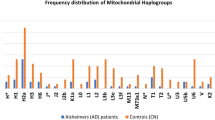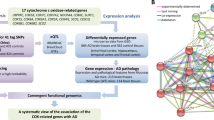1. Alzheimer’s disease (AD) is the most common form of dementia in the elderly in which interplay between genes and the environment is supposed to be involved. Mitochondrial DNA (mtDNA) has the only noncoding regions at the displacement loop (D-loop) region that contains two hypervariable segments (HVS-I and HVS-II) with high polymorphism. mtDNA has already been fully sequenced and many subsequent publications have shown polymorphic sites, haplogroups, and haplotypes. Haplogroups could have important implications to understand the association between mutability of the mitochondrial genome and the disease.
2. To assess the relationship between mtDNA haplogroup and AD, we sequenced the mtDNA HVS-I in 30 AD patients and 100 control subjects. We could find that haplogroups H and U are significantly more abundant in AD patients (P = 0.016 for haplogroup H and P = 0.0003 for haplogroup U), Thus, these two haplogroups might act synergistically to increase the penetrance of AD disease.
Similar content being viewed by others
REFERENCES
Anderson, A., Bankier, A. T., Barrel, B. G., de Bruijn, M. H., Coulson, A. R., Drouin, J., Eperon, I. C., Nierlich, D. P., Roe, B. A., Sanger, F., Schreier, P. H., Smith, A. J., Staden, R., and Young, I. G. (1981). Sequence and organisation of the human mitochondrial genome. Nature 290:457–465.
Arnestad, M., Opdal, S. H., Musse, M. A., Vege, A., and Rognum, T. O. (2002). Are substitution in the first hypervariable region of mitochondrial DNA displacement-loop in sudden infant death syndrome due to maternal inheritance? Acta Pediatr. 91:1060–1064.
Bennett, D. A., Schneider, J. A., Wilson, R. S., Bienias, J. L., and Arnold, S. E. (2004). Neurofibrillary tangles mediate the association of amyloid load with clinical Alzheimer disease and level of cognitive function. Arch. Neurol. 61:378–384.
Bosetti, F., Brizzi, F., Barogi, S., Mancuso, M., Siciliano, G., Tendi, E. A., Murri, L., Rapoport, S. I., and Solaini, G. (2002). Cytochrome c oxidase and mitochondrial F (1) F (0)—ATPase (ATP synthase) activities in platelets and brain from patients with Alzheimer disease. Neurobiol. Aging 23:371–376.
Brown, M. D., Torroni, A., Reckord, C. L., and Wallace, D. C. (1995). Phylogenetic analysis of Leber’s hereditary optic neuropathy mitochondrial DNA’s indicates multiple independent occurrences of the common mutations. Hum. Mutat. 6:311–325.
Coskun, P. E., Beal, M. F., and Wallace, D. C. (2004). Alzheimer’s brains harbor somatic mtDNA control region mutations that suppress mitochondrial transcription and replication. PNAS 101:10726–10731.
Cottrell, D. A., Borthwick, G. M., Johnson, M. A., Ince, P. G., and Turnbull, D. M. (2002). Role of mitochondrial DNA mutations in disease and aging. Neuropathol. Appl. Neurobiol. 28:390–396.
Graven, L., Passarino, G., Semino, O., Boursot, P., Santachiara-Benerecetti, S., Langaney, A., and Excoffier, L. (1995). Evolutionary correlation between control region sequence and restriction polymorphisms in the mitochondrial genome of a large Senegalese Mandenka population. Mol. Biol. Evol. 12:334–345.
Harman, D. (2002). Alzheimer’s disease: Role of aging in pathogenesis. Ann. N.Y. Acad. Sci. 959:384–395.
Hassani-Kumleh, H., Houshmand, M., Shafa Shariat Panahi, M., Riazi, G. H., Sanati, M. H., Gharagozli, K., and Ghabaee, M. (2006). Mitochondrial D-loop variation in Persian multiple sclerosis patients: K and A haplogroups as risk factors! Cell. Mol. Neurobiol. 26:119–125.
Hofmann, S., Jaksch, M., Bezold, R., Mertens, S., Aholt, S., Paprotta, A., and Gerbitz, K. D. (1997). Population genetics and disease susceptibility: Characterization of central European haplogroups by mtDNA gene mutations, correlation with D loop variants and association with disease. Hum. Mol. Genet. 6:1835–1846.
Lertrit, P., Kapsa, R. M., Jean-Francois, M. J., Thyagarajan, D., Noer, A. S., Marzuki, S., and Byrne, E. (1994). Mitochondrial DNA polymorphism in disease: A possible contributor to respiratory dysfunction. Hum. Mol. Genet. 3:1973–1981.
Macaulay, V., Richards, M., Hickey, E., Vega, E., Cruciani, F., Guida, V., Scozzari, R., Bonne-Tamir, B., Sykes, B., and Torroni, A. (1999). The emerging tree of West Eurasian mtDNAs: A synthesis of control-region sequences and RFLPs. Am. J. Hum. Genet. 64:232–249.
Obermaier-Kusser, B., Lorenz, B., Schubring, S., Paprotta, A., Zerres, K., Meitinger, T., Meire, F., Cochaux, P., Blankenagel, A., Kommerell, G., Jaksch, M., and Gerbitz, K.-D. (1994). Features of mtDNA mutation patterns in European pedigrees and sporadic cases with Leber hereditary optic neuropathy. Am. J. Hum. Genet. 55:1063–1066.
Ozawa, T., Tanaka, M., Ino, H., Ohno, K., Sano, T., Wada, Y., Yoneda, M., Tanno, Y., Miyatake, T., Tanaka, T., Itoyama, S., Ikebe, S., Hattori, N., and Mizuno, Y. (1991). Distinct clustering of point mutations in mitochondrial DNA among patients with mitochondrial encephalomyopathies and with Parkinson’s disease. Biochem. Biophys. Res. Commun. 176:938–946.
Shoffner, J. M., Brown, M. D., Torroni, A., Lott, M. T., Cabell, M. F., Mirra, S. S., Beal, M. F., Yang, C. C., Gearing, M., Salvo, R., Watts, R. L., Juncos, J. L., Hansen, L. A., Crain, B. J., Fayad, M., Reckord, C. L., and Wallace, D. C. (1993). Mitochondrial DNA variants observed in Alzheimer disease and Parkinson disease patients. Genomics 17:171–184.
Smith, M. A., Drew, K. L., Nunomura, A., Takeda, A., Hirai, K., Zhu, X., Atwood, C. S., Raina, A. K., Rottkamp, C. A., Sayre, L. M., Friedland, R. P., and Perry, G. (2002). Amyloid-beta, tau alterations and mitochondrial dysfunction in Alzheimer disease: The chickens or the eggs? Neurochem. Int. 40:527–531.
Torroni, A., Houponen, K., Francalacci, P., Petrozzi, M., Morelli, L., Scozzari, R., Obinu, D., Savontaus, M. L., and Wallace, D. C. (1996). Classification of European mtDNAs from an analysis of three European populations. Genetics 144:1835–1850.
Torroni, A., Petrozzi, M., D’Urbano, L., Sellitto, D., Zeviani, M., Carrara, F., Carducci, C., Leuzzi, V., Carelli, V., Barboni, P., De Negri, A., and Scozzari, R. (1997). Haplotype and phylogenetic analysis suggest that one European-specific mtDNA background plays a role in the expression of Leber Hereditary Optic Neuropathy by increasing the penetrance of the primary mutations 11778 and 14484. Am. J. Hum. Genet. 60:1107–1121.
Van Der Walt, J. M., Dementieva, Y. A., Martin, E. R., Scott, W. K., Nicodemus, K. K., Kroner, C. C., Welsh-Bohmer, K. A., Saunders, A. M., Roses, A. D., Small, G. W., Schmechel, D. E., Murali Doraiswamy, P., Gilbert, J. R., Haines, J. L., Vance, J. M., and Pericak-Vance, M. A. (2004). Analysis of European mitochondrial haplogroups with Alzheimer disease risk. Neurosci. Lett. 365:28–32.
Weissman, S. M. (1995). Genetic basis for common polygenic diseases. Proc. Natl. Acad. Sci. U.S.A. 92:8543–8544.
Author information
Authors and Affiliations
Corresponding author
Rights and permissions
About this article
Cite this article
Fesahat, F., Houshmand, M., Panahi, M.S.S. et al. Do Haplogroups H and U Act to Increase the Penetrance of Alzheimer’s Disease?. Cell Mol Neurobiol 27, 329–334 (2007). https://doi.org/10.1007/s10571-006-9126-9
Received:
Accepted:
Published:
Issue Date:
DOI: https://doi.org/10.1007/s10571-006-9126-9




